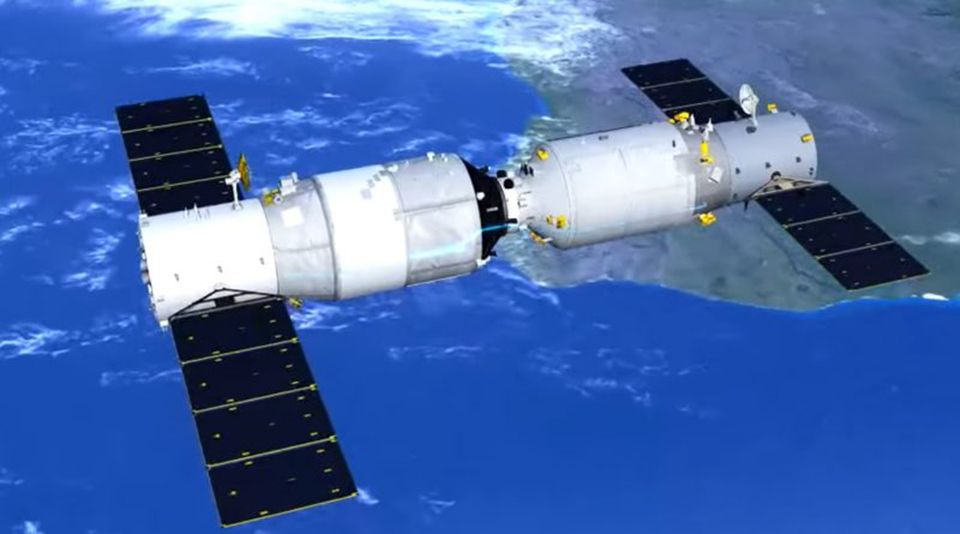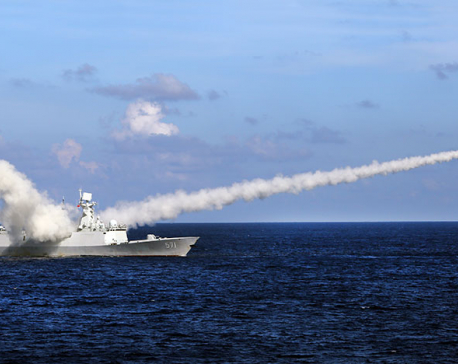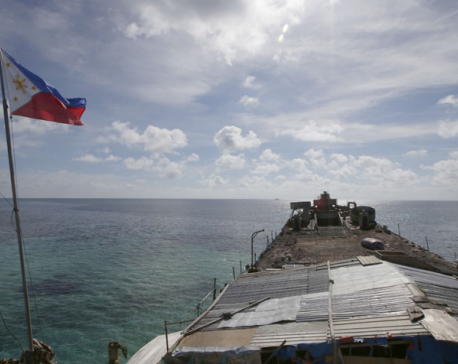
OR
Second Chinese space station set to fall to Earth next year
Published On: September 30, 2018 04:40 PM NPT By: Agencies

BEIJING, Sept 30: China is planning to bring its second space lab back to Earth in July 2019 in a 'controlled deorbit', the country's space agency has revealed.
It comes just six months after the country's first space lab, named Tiangong-1, made international news when it infamously plummeted out of orbit in an uncontrolled descent.
It fell into the South Pacific Ocean in April, mostly burning up in the atmosphere before it reached the ocean.'Tiangong-2 has fulfilled its mission during the two-year time, and all the loads are now in good condition,' said Lin Xiqiang, deputy director of the China Manned Space Engineering Office, according to state media.
'It will be in orbit until July 2019, and then will be controlled to deorbit.'
In 2016, two astronauts spent a month inside Tiangong-2 as part of China's longest-ever crewed space mission.
According to state media, they conducted experiments related to medicine, physics and biology.Tiangong-2 is the second Chinese experimental space station. It was launched aboard a Long March 2F rocket on 15 September 2016.
The 34 ft (10.4 m) long, 14 ft (4.2 m) wide station weighs 19,000 lb (8,600 kg) and is being used for 'testing systems and processes for mid-term space stays and refueling,' according to the Chinese State.
It is conducting experiments ahead of a Chinese space station planned for 2022.
The Tiangong-2 spacecraft was recently observed plummeting around 60 miles (95 km) toward the surface of the planet.
It has since returned to its normal orbital height, sparking speculation that China may be preparing to decommission the vessel in the near future.
China will be hoping to avoid an embarrassing repeat of the events of April, when the nation's out-of-control Tiangong-1 space station returned to Earth with a bang. Tiangong-1 was launched in September 2011 and spent at least five years in operation before it 'ceased functioning' in March 2016, according to the Chinese space agency officials.
It was not revealed why it had suddenly stopped working.
The Tiangong program (Tiangong means 'Heavenly Palace' in English) is intended as the initial steps towards China's ultimate space goal: launching a permanent space station around 2022.
But a space station is just one part of the Chinese government's wide-ranging ambitions when it comes to its space program.
In August, Beijing unveiled the rover it was planning to send to explore the 'dark side' of the moon later in 2018, while the launch of the country's first Mars probe is planned for 2020.
'Our overall goal is that, by around 2030, China will be among the major space powers of the world,' Wu Yanhua, deputy chief of China's national space agency, told reporters in 2016.Tiangong-1 spiralled out of control, with little certainty possible about when and where it might land.
China's controlled thrust tests, lowering and raising the satellite on command, hint at a desire to bring the station down at a time and place of their choosing.
While it is unclear exactly when they plan to do so, an area known as the 'satellite graveyard' seems a likely location for touch down.
This is a region of the South Pacific Ocean commonly used by Russian and US space agencies to dump debris.
To track the satellite's orbital path above the Earth in realtime, visit Satview.Tiangong-2 is the second Chinese experimental space station. It was launched aboard a Long March 2F rocket on 15 September 2016.
It is 34 ft (10.4 m) long, 14 ft (4.2 m) in diameter and has a mass of 19,000 lb (8,600 kg).
The module is being used for 'testing systems and processes for mid-term space stays and refuelling,' according to the Chinese State.
It is conducting experiments ahead of a Chinese space station planned for 2022.
In October 2017, Chinese astronauts spent a 30-day stay on the station - China's longest stay in space.
China's out of control Tiangong-1 space station smashed into Earth at 17,000 mph (27,358 kph) off the coast of Tahiti on April 2, 2018, and mostly disintegrated as it hit the planet's atmosphere.The demise of the nine-ton space station had been the subject of scientific speculation for months amid fears large chunks of it could come down near population centres.
Experts had been unable to predict where the installation, which is roughly the size of a school bus, would come down but in the end it re-entered the earth's atmosphere over the South Pacific.
The craft re-entered the atmosphere around 8.15am Beijing time (12.15am GMT) and the 'vast majority' of it had burnt up upon re-entry, the China Manned Space Engineering Office said at the time.
Authorities said any debris from the space station would be carrying hydrazine - a high toxic rocket fuel - and warned people to refrain from touching it or inhaling its fumes.
You May Like This

Chinese state tabloid warns Trump, end one China policy and China will take revenge
SHANGHAI/TAIPEI, Jan 9: State-run Chinese tabloid Global Times warned U.S. President-elect Donald Trump that China would "take revenge" if he reneged... Read More...

China announces South China Sea military exercises
BEIJING, July 18: China said Monday that it is closing off a part of the South China Sea for military exercises... Read More...

South China Sea ruling deepens tensions between US, China
WASHINGTON, Jul y 10: A landmark international tribunal ruling on the South China Sea threatens to sharpen the differences between... Read More...

Just In
- Sajha Yatayat cancels CEO appointment process for lack of candidates
- Govt padlocks Nepal Scouts’ property illegally occupied by NC lawmaker Deepak Khadka
- FWEAN meets with President Paudel to solicit support for women entrepreneurship
- Koshi provincial assembly passes resolution motion calling for special session by majority votes
- Court extends detention of Dipesh Pun after his failure to submit bail amount
- G Motors unveils Skywell Premium Luxury EV SUV with 620 km range
- Speaker Ghimire administers oath of office and Secrecy to JSP lawmaker Khan
- In Pictures: Families of Nepalis in Russian Army begin hunger strike















_20240419161455.jpg)

Leave A Comment